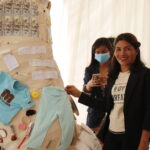by Aileen Kwa
español
(GENEVA, 30 November) There is ambiguity in the section on services in the draft Ministerial text (Annex C) (1). Parts of the text have been drafted in a deliberately subtle manner to make it unclear whether or not there will be sectoral negotiations that will commence in GATS negotiations post-Hong Kong, such as those that took place in telecommunications and financial services in 1997.
In Geneva, the main fights between the developed countries and the majority of developing countries in the past weeks have been over the issue of numerical targets – a formula approach to opening up services sectors. (2) This will clearly change the GATS architecture from the current flexible bottom-up approach. There has been strong opposition and that battle staged by developing countries, led by Brazil, has been rather successful.
However, because of the textual ambiguities, a dangerous development — in many ways much more problematic than “numerical targets” — has until recently been left languishing.
Developing country delegates have not completely realized the dangers lying in two seemingly innocuous paragraphs(7a-c). (3 and Annex 1) They have read paragraph 7 with the understanding that it is advocating a “plurilateral request-offer” approach (for example, five developed countries coming together to make a request from ASEAN). In fact, they have been deliberately misled, since they have been told by their developed country partners that the joint LDC request to key developed countries on Mode 4 is an example of this “plurilateral request-offer” approach. However, the intentions of the EU and US go beyond this negotiating modality. They want sectoral negotiations in GATS to commence post-Hong Kong, using the Hong Kong text as the basis to do so.
What is the difference between the “plurilateral request-offer” and sectoral negotiations? The plurilateral process, similar to the bilateral request and offer, is informal. It takes place between demandeurs and those they are seeking higher commitments from.
There are no formal negotiating sessions. There is no formal Chair.
There are no minutes of these informal negotiations. And importantly, there is no “critical mass” of countries (representing 80-90% of world trade in that sector) unless the negotiations draw in such a large number of countries, as to effectively make up this “critical mass” (an unlikely situation if it were completely voluntary).
That negotiations can take place through a plurilateral request-offer approach is already outlined in paragraph 11 of the negotiating guidelines agreed to by all members before the GATS negotiations commenced in 2001.
However, should the “plurilateral request-offer” gain momentum at some point and become a large enough “critical mass”, the nature of the negotiations can easily take on the trappings of sectoral negotiations as with telecoms. It is this subtle difference that is being played out in the ambiguous draft text, which the demandeurs will immediately capitalize on post-Hong Kong.
The draft Hong Kong text is pushing the “plurilateral request-offer”
into a mode which will ensure this “critical mass”. Paragraphs 7a and b allow for groups of countries to make requests of other groups of countries. Since it is highly unlikely that developing countries will voluntarily walk into these aggressive negotiations, 7b
makes it mandatory for countries being requested, to do so.
Annex C is given full legal status in paragraph 9 of the current main draft Ministerial text for Hong Kong, which states “We are determined to intensify the negotiations in accordance with the above principles and the Objectives, Approaches and Timelines set out in Annex C to this document with a view to expanding the sectoral and modal coverage of commitments and improving their quality.”
WHAT IS THE GAME PLAN OF US AND EC IN SECTORAL NEGOTIATIONS?
There are huge economic gains for the US and EU in services liberalisation. Although seventy per cent of the global economy is made up of services, it accounts for only 20 per cent total world trade.
In Geneva, on the sidelines of the bilateral request-offer process, “friends groups” – driven by exporting countries – have mushroomed and in fact have been the driving force of the bilateral request-offer process. They have come together to chart out the main barriers in each of their services sectors, and this work has informed their governments in the negotiations. They have produced model schedules of commitments they would like the developing world to bind in the WTO, identified exactly the countries that would make up the needed critical mass, and the main barriers in each of these countries. There are about 15 or so friends groups, including friends of financial services; telecoms; audiovisuals; computer services; environmental services; distribution; maritime; mode 4; postal services; construction services; tourism; logistics; energy; legal services.
The game plan of the US and EC (and India due to mode 4) is to give the work of the friends groups a formal platform in the WTO and with time, to draw in this critical mass through force such as in the language in 7b, or through technical assistance, or political pressure as was the case in financial services. The ambition is to replicate what happened in telecoms and financial services by drawing up a baseline of harmonized regulatory commitments across most of the world. Since this agenda is driven by exporting countries, this framework of regulatory obligations and commitments will fall on the side of requiring investment and competition policy provisions which safeguard the interests of foreign firms rather than local suppliers. This is exactly the case in the Telecoms Reference Paper which even disallows cross- subsidisation (a tool often used by governments and regulators to allow for universal provision of services).
As Robert Wolfe, Associate Professor of Queen’s University, Ontario comments, referring to the Telecom Reference Paper, “The GATS does not give states the right to regulate; GATS subtracts from that right to the extent needed for liberalisation”. (4)
The ambition to change the nature of GATS negotiations into more formal sectoral negotiations is captured in a recent speech by Robert Vastine, President of the US Coalition of Service Industries (CSI):
“If the services negotiations produce good results, it might well be because of ideas generated by Friends Groups. To be effective, however, they must energetically recruit a larger circle of Members, in order to reach a “critical mass” which will allow them to go public with their proposals and secure wide acceptance of
them.”(5)
Referring to the Telecoms and Financial Services negotiations, Vastine highlights them as modals to be followed in the current
negotiations:
“The two negotiations created a new sense of optimism about the potential for successful services negotiations in a broader round.
They… led to high expectations that substantial reductions in barriers to services trade could be achieved in a larger negotiation starting in 2000 as required by the built in agenda”. (6)
Note, too, that in the Uruguay Round it was decided that the Round would conclude but these sectoral negotiations will continue beyond it. Four sectors were attempted: maritime, mode 4, telecoms and finance. Negotiations in sectors of prime interest to the major countries worked – telecoms and financial services. The other negotiations collapsed.
Similarly, the intention of US and EU is to push to conclude the Doha Round by 2006/7, but to have sectoral GATS negotiations continue after the Doha Round, ideally in about 15 sectors mirroring those of the friends groups.
THE PITFALLS OF SECTORAL NEGOTIATIONS FOR DEVELOPING COUNTRIES
Services is unlike agriculture and NAMA where the traditional method of market protection is through tariffs. For services, liberalisation entails the removal of regulatory requirements that impose limits on foreign investors e.g. limits on commercial presence or foreign ownership of companies. And according to Richard Self, Chief US negotiator for services in the Uruguay Round, “the single focus of the sector initiative alone has great value in promoting the interests of countries seeking improved commitments in the sector or mode.”(7)
For developing countries, such commitments are highly
problematic:
First, the deep level of regulatory obligations tend to put liberalisation and “pro- competitive” objectives and the rights of foreign firms ahead of national objectives such as universal provision.
This regulatory framework is unlikely be one that most developing countries would like, one which allows for strong local service industries to develop. (See Annex 2 on WTO dispute between US and Mexico on Telmex.) This will have a severe impact on countries’ economic development process.
Second, this type of regulation will mirror the regulatory frameworks already in existence in the developed world, but will be a huge burden and danger for developing countries. Even most “advanced” developing countries are still learning the ABCs of regulation. This lack of experience, and in fact, the non-existence of adequate national regulation, will be a huge disadvantage in their negotiations with their developed partners.
Third, in sectoral negotiations, there is — in theory — the concept of freedom and flexibility. However, de facto, there is an obligation for all members of the WTO, whether one is in the sectoral negotiations or outside. For those inside, they can in theory take on the commitments in whole or part. Similarly those outside can completely reject being a part of these negotiations. However, in practice, once a baseline of commitment or regulatory framework has been agreed, it becomes a minimum “norm” bound under international law which will be used by foreign investors as a yard stick to evaluate all countries. This norm will be seen as their minimum guarantee to protect their interests. This affects all WTO members, inside or outside the negotiations and this hidden obligation cannot be underestimated.
Fourth, the services markets will be even more highly concentrated when developing country markets are pried open. Most developing countries do not have export capacity of any significant proportion.
Most are importers of services. In an even more concentrated environment, it would be extremely difficult, if not impossible, for the developing world to nurture their local service industries, with detrimental impact on their future economic development.
* Aileen Kwa is a research associate with Focus on the Global South. She has been tracking WTO negotiations for 10 years.
ANNEX 1: DRAFT MINISTERIAL TEXT
ANNEX 1: DRAFT MINISTERIAL TEXT
Paragraphs 7 a-c (Annex C) masquerades as a plurilateral request-offer, but is an opening for sectoral initiatives to commence, must
be deleted. This language goes beyond the language in the Negotiating Guidelines and must not be accepted.
Paragraph 11b (Annex C) “Groups of members presenting plurilateral requests to other Members should submit this by [Feb
2006…]” must also be deleted.
Paragraph 9 of the main Ministerial Draft text stipulating that negotiations must be intensified through sectoral and modal
coverage of commitments must also be deleted. This is contrary to the Negotiating Guidelines and flexibilities enshrined in GATS.
ANNEX 2: US-MEXICO DISPUTE ON TELMAX
In April 2004, the WTO dispute panel ruled against Mexico in a case brought to the WTO by the US on the grounds that Mexico’s
laws and regulations were anti-competitive and contravened Section 1 of the Telecoms Reference Paper to which Mexico had
signed. The panel ruled that Mexico had failed to ensure that US basic telecom suppliers had equal access to, and use of, public
telecom networks and services. The Mexican company Telmex had charged the US supplier higher interconnection rates. Mexico tried
to defend its regulation on rates charged on the basis that they were designed to include the costs for rolling out
telecommunications infrastructure – a need of developing countries.
The panel however, accepted the US argument that the rates charged should be based solely on the specific services foreign
companies required. No contribution to development of Mexico’s telecommunications infrastructure could be included in the rate.
Mexico also argued that its commitments had to be interpreted in the light of the special and differential treatment provisions in the
GATS – paragraph 5 of the preamble and GATS Article IV which recognizes that Members need to “strengthen their domestic
service capacity and efficiency and competitiveness”. However, the panel concluded:
“These provisions describe the types of commitments that Members should make with respect to developing country
Members; they do not provide an interpretation of commitments already made by those developing country Members”.
Source: UNCTAD 2005 “Trade in Services and Development Implications”, TB/B/COM.1/71. Gould, Ellen, “WTO Panel Rules
Against Special and Differential Treatment for Development Countries”,
www.mediatrademonitor.org/node/view/8
NOTES
1. Ministerial Text, 26 November 2005, JOB(05)/298.
2. The EC has proposed that developed countries open up 139 of the
163 subsectors, and developing countries open up 93 sub-sectors.
The US has contributed to the fire in the past week by floating
around their “collective targets” proposal (developing countries as a
group will collectively open up an agreed number of sub-sectors).
3.
Paragraph 7 reads: “In addition to bilateral negotiations, we agree
that the request/offer negotiation should also be pursued on a
plurilateral basis in accordance with the principles of the GATS and
the Guidelines and Procedures for the Negotiations on Trade in
Services. The results of such negotiations shall be extended on an
MFN basis. These negotiations would be organized in the following
manner: a. Any Member of group of Members may present
requests or collective requests to other Members in any specific
sector or mode of supply, identifying their objectives for the
negotiations in that sector or mode of supply b. A Member or group
of Members who have made such requests in a specific sector or
mode of supply, together with Members to whom such requests
have been made, and any other interested Member, shall enter into
plurilateral negotiations to consider such requests. c. Plurilateral
negotiations should be organized with a view to facilitating the
participation of all Members, taking into account the limited
capacity of smaller delegations to participate in such negotiations.”
(JOB(05)/298 26November 2005) 4. Wolf Robert, “Regulatory
Transparency, Developing Countries and the Fate of the WTO”,
http://www.cpsa-acsp.ca/paper-2003/wolfe.pdf 5. Vastine, Robert
2005 “Services Negotiations in the Doha Round: Promise and
Reality”, Conference on Perspectives on the Doha Development
Agenda, Gerald R. Ford School of Public Policy, University of
Michigan, October 21.
http://www.uscsi.org/publications/papers/UMichPaper_102105.pdf 6. Vastine, 2005 ibid. 7. Self, Richard 2005 “Revitalizing the WTO
Services Negotiations with Development Friendly Approaches”.
Paper commissioned by DFID.








